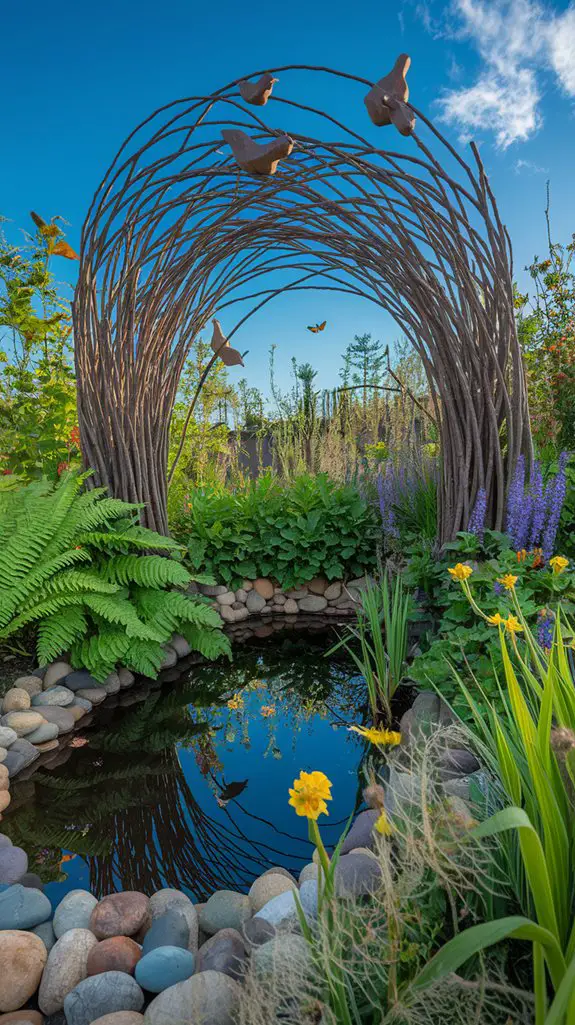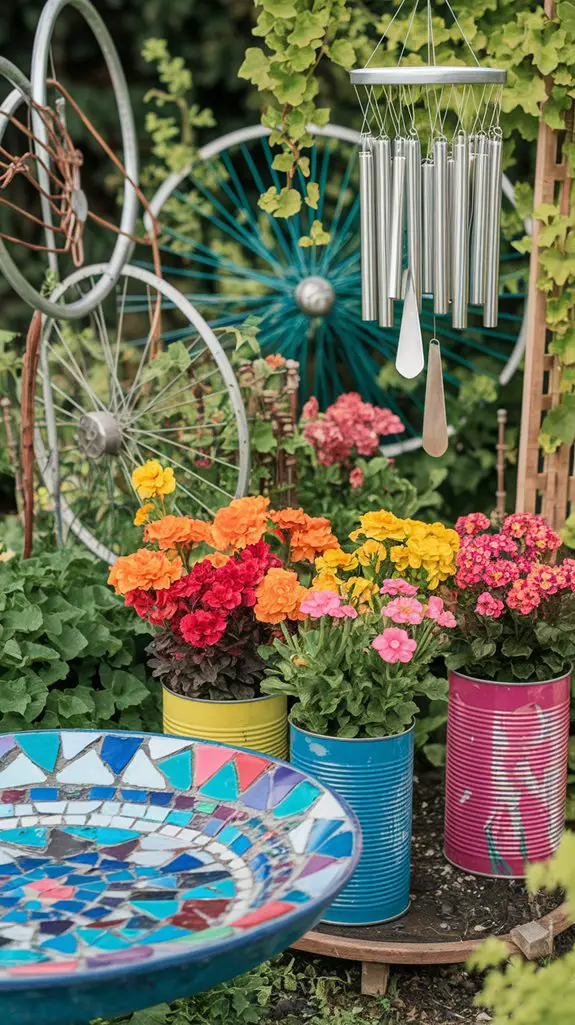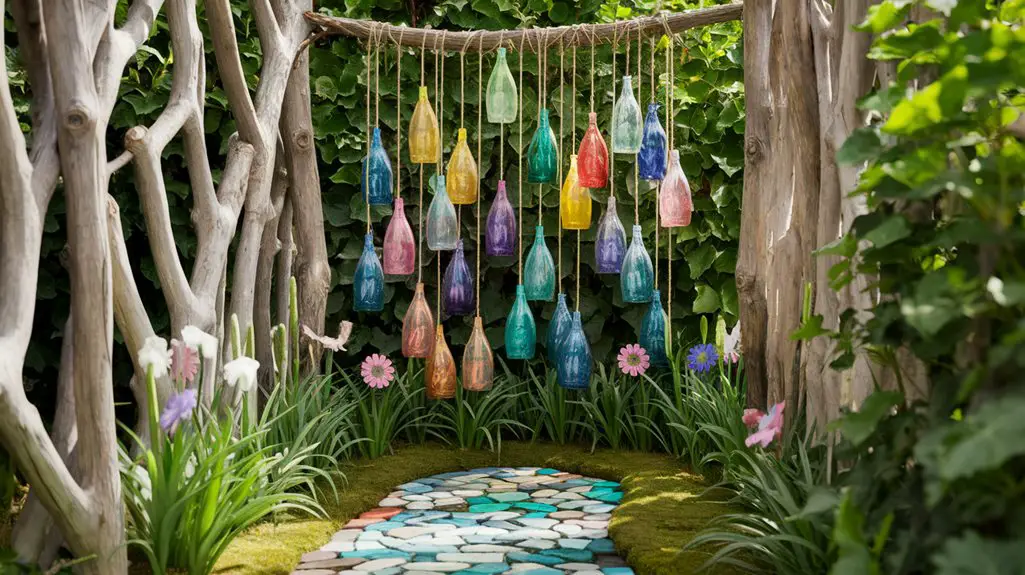When you create art for your garden, you’re not just decorating—you’re making a statement about your relationship with the natural world. Eco-friendly installations transform outdoor spaces while respecting the ecosystem that hosts them. You’ll find that sustainable materials often bring unexpected textures and authenticity that mass-produced decorations lack. As seasons change, your thoughtful creations will weather and evolve alongside the living elements of your garden, telling a story that commercial alternatives never could.
Sourcing Sustainable Materials for Garden Art
When you begin creating eco-friendly garden art, the materials you choose form the foundation of your environmental impact.
Look for reclaimed wood from old barns, fallen branches, or construction salvage to serve as your primary medium. Driftwood gathered responsibly from beaches offers weathered texture and natural beauty.
Consider incorporating recycled metals like copper piping, aluminum cans, or steel scraps that you’ll find at scrapyards or recycling centers.
For color elements, seek out non-toxic, water-based paints labeled for outdoor use and low VOCs.
Don’t overlook natural fibers like jute, hemp, or coconut coir for binding or weaving components. Local stone, clay, and sand provide earthy elements without transportation emissions. Additionally, using low-impact materials can further enhance the sustainability of your garden art creations.
Designing Art Installations That Complement Natural Ecosystems

Creating art that truly belongs in a garden requires thoughtful integration with the existing ecosystem rather than imposing upon it.
You’ll want to observe your garden’s natural flow, noting how light, water, and wildlife interact throughout the seasons.
Consider designing installations that serve dual purposes—like sculptures that double as bird baths or pollinator habitats. Incorporating creative outdoor sculptures can enhance both aesthetics and functionality, making your garden a more inviting space for wildlife.
Choose colors and forms that echo your surrounding flora, creating visual harmony rather than jarring contrasts. Height and scale matter too; your art shouldn’t overwhelm delicate plantings or block essential sunlight.
The most successful eco-conscious installations evolve with your garden.
Think about how rain, wind, and time will affect your piece. Will it weather gracefully? Can components be easily repaired or composted at the end of their life?
When your art supports natural processes, it becomes a living part of the ecosystem.
Upcycling Household Items Into Garden Masterpieces

Before discarding everyday objects, you’d be surprised how many household items can transform into striking garden art with minimal effort. Your kitchen, garage, and recycling bin hold treasures waiting for creative rebirth in your outdoor sanctuary.
| Item | Upcycling Potential | Environmental Benefit |
|---|---|---|
| Old silverware | Wind chimes, garden markers | Diverts metal from landfills |
| Glass bottles | Edging, light catchers | Reduces glass waste |
| Broken ceramics | Mosaic stepping stones | Gives new life to broken items |
Look for weather-resistant materials that won’t leach harmful chemicals into your soil. Consider each piece’s visual harmony with your plants and landscape. By repurposing with intention, you’re not only creating unique artistic expressions but also extending objects’ lifecycles, reducing consumption, and honoring the earth’s limited resources. Incorporating green materials for DIY projects can further enhance your commitment to sustainability and creativity in your garden decor.
Creating Living Art With Native Plants and Organic Shapes
Native plants serve as nature’s most elegant artistic medium, offering a sustainable palette that evolves with the seasons.
When designing your living art installation, embrace the flowing curves and asymmetry found in natural landscapes. You’ll create more visual interest by arranging plants in organic clusters rather than rigid rows.
Select species indigenous to your region that attract local pollinators while requiring minimal water and maintenance. Consider incorporating native plants for wildlife habitats that provide essential resources for local fauna.
Consider how your installation will transform throughout the year—spring blooms, summer textures, fall colors, and winter silhouettes all contribute to the living canvas.
Incorporate elements like meandering pathways, gentle mounds, or dry creek beds to enhance the natural aesthetic.
Remember that patience is key; unlike traditional art, your living installation will mature and develop complexity over time, becoming more beautiful as it establishes itself.
Weather-Resistant Eco-Friendly Finishes and Preservation Methods
When exposed to the elements, outdoor art installations require thoughtful preservation approaches that won’t harm the environment.
Consider plant-based oils like linseed or tung oil for wooden elements—they penetrate deeply while maintaining a natural look. For metal pieces, beeswax coatings offer protection without toxic chemicals that leach into soil.
Borax solutions work effectively against fungi and insects for biodegradable materials, while milk paint provides vibrant color options without VOCs.
You’ll find that silica-based water repellents create invisible shields against moisture damage for stone or ceramic components. Additionally, using sustainable materials ensures that your installations contribute positively to the ecosystem.
Remember to reapply these natural finishes seasonally. Incorporate sacrificial elements in your design that can decompose naturally while preserving the core structure.
Conclusion
Let your garden art become a million little ambassadors for our planet. By merging creativity with conservation, you’ve created more than decorations—you’ve built habitats that honor Earth’s resources. Your sustainable installations will inspire neighbors and nurture wildlife while weathering seasons gracefully. Remember, every recycled piece and native plant incorporated isn’t just art—it’s a love letter to nature that future generations will thank you for.




